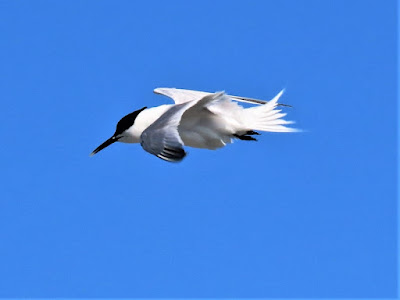Today was time for my annual pilgrimage to
Anglesey with two destinations.
Firstly to the North Wales Wildlife Trust managed Cemlyn Bay. This a nest area for Common, Arctic and Sandwich Terns (and Black-headed Gulls, but we will ignore them).
Then on to the RSPB Reserve at South Stack for thousands of breeding Guillemots and Razorbills. There are always a few Puffins though this year all the individuals from just four breeding pairs eluded me. Not so the other highlight of the area - Chough. One was most obliging.
Here are a few photos:
Sandwich Terns are the largest of the trio of terns easily separated by their yellow-tipped black bill.
They have a shaggy crest when on the ground and that is just visible on the nape as this bird flies by.
Here we see the outer wing is darker than the rest of the wing and body. The tail has a rather short fork. Behind it is a Common Tern carrying food. The main separation here is the more elongate shape. Common is smaller than Sandwich though that is hard to judge here because they are different distances from the camera.
A flying view showing the relatively long wing. I would say they are 'elegant-looking' but there is a New World species named Elegant Tern which is even more 'elegant'.
This one has been fishing and is carrying food back to the nest. At this stage likely part of the pair-bonding ritual as there was no obvious sign of chicks as yet.
It was very busy with birds passing all the time. Two Sandwich Terns here.
And three here.
I mentioned the shaggy crest on this species. After fishing in salt water here a group wash in fresh water with the crests clearly visible.
Here is a Common Tern showing a black-tipped orange bill. It too has darker area on the outer wing. Note too the broad dark trailing edge to the underwing. These features separate it from...
...the Arctic Tern which shows a shorter all-red bill. a cleaner all-pale upper wing and longer tail streamers. The black on the head is more of a cap whereas...
...on this Common Tern the black extends more on to the nape. None of these features is easy to see with the eye as birds twist and turn in flight.
Another view of Common Tern.
Here is one also carrying food back to the nest.
A trio at their nests. For obvious reasons it is not allowed to approach the main nesting area. These birds had chosen to nest just 'over the shingle ridge' and holding the camera high above my head enabled this view.
A classic Common Tern fly-by.
Arctic Terns seemed to be rather camera-shy despite the warden's assurance that there were similar numbers of breeding Arctic and Common Terns. These two Arctic Terns were having a dispute above my head calling and climbing higher and higher in the sky.
Here as they interact, note the mainly translucent area to the underwing trailing edge also shows a thin black line on the outermost part. Note also the long outer tail-feathers.
They went up and up and up...
...and eventually became too small to photo. And no: they area not starting to leave a vapour trail – that was a passing airliner!
An unexpected (but very distant) sighting was this Black Guillemot. In breeding plumage this species is jet-black with a large white wing panel. In winter it becomes a ghostly grey though it is rarely seen in this plumage as it spends winter far out in the Atlantic. Mainly a northern species just a few pairs breed in secluded bays along the North Anglesey coast.
Then it was on to South Stack for the Guillemots and Razorbills (but no Puffin for me this year). The nesting ledges are a long way from the viewing areas and a digiscope would be needed for photography. Here is a group of off-duty birds loafing on a rock. There is no nest as such with the single egg laid a on narrow ledges. Only one bird can attend at any one time.
With 11 Guillemots there is one Razorbill (at the bottom right). Slightly smaller and with a differently-shaped bill, Razorbills can, with practice, be separated even at distance as they are black whereas Guillemots are very dark chocolate brown.
This was about my fifth visit to South Stack and was the first time I have encountered Wheatear. Here is a female.
And an enlarged view of a distant and slightly more colourful male.
A not entirely unexpected species was this Rock Pipit. The three UK nesting pipit species are not easy to separate visually with habitat and song being the best clues during the breeding season. In Cornwall I used to reckon that any pipit between the coast path and the sea was a Rock Pipit with Meadow Pipit the other side of the path. Helpfully on a rock: so Rock Pipit it is. (Tree Pipit is to be found where there are trees near heathland).
Looking for inspiration? Probably watching out for predators.
Always a much-looked for species by visitors and not always obliging is Chough. It was very obliging for me.
It uses it curved red bill to dig for goodies in short-turf grass. This habitat is often on areas exposed to salt-water spray, stunting growth of the grass. An on-going monitoring programme of this near threatened species is responsible for the 'bling' on its legs.
Dig, dig, dig.
Look: no visible means of support!
(Ed Wilson)

















































